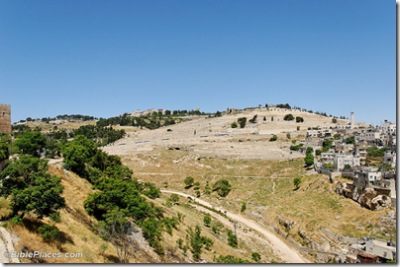The Israeli government is moving towards making the Mount of Olives a protected national park.
From Arutz-7:
The Knesset has taken the first step towards legislating the establishment of a new national authority that will preserve, rebuild and protect the ancient Mt. of Olives cemetery. The bill has passed its preliminary reading, and is being prepared for its additional readings….Without a national body coordinating efforts on the site’s behalf, “there is no one to preserve it, and no one to prevent illegal construction and vandalism there.”
Mt. of Olives overlooks the Old City of Jerusalem and the Temple Mount, and its summit is crowned by the Intercontinental Hotel. An estimated 20,000 gravesites remain in the ancient cemetery, out of some 70,000 – according to the lower estimates – that were there before the Jordanians took control of the site in 1948….
Of late, vandalism of Mt. of Olives gravestones has been discovered periodically. Just this past February, MKs of the Knesset’s State Control Committee toured the cemetery for the purpose of examining the many complaints of desecration, graffiti and smashed headstones. MK Zevulun Orlev (NRP) said at the time, “If such vandalism had occurred in a Jewish cemetery in Europe, it would shock the entire Jewish world; law enforcement authorities would attempt to capture the guilty parties… This is happening in the heart of the capital of Israel, adjacent to the Western Wall, [yet] the sovereign Jewish regime remains apathetic.”
Among the many famous Jewish historical figures buried on the Mt. of Olives are:
- Rabbi Moshe Ben-Nachman (Ramban)
- Rabbi Avraham Yitzchak Kook
- his son Rabbi Tzvi Yehuda Kook
- Israeli Chief Rabbi Shlomo Goren
- the Gerrer Rebbes
- Prime Minister Menachem Begin
- Nobel Prize laureate author S. Y. Agnon
- British Chief Rabbi Lord Immanuel Jakobovits
- Eliezer Ben-Yehuda, the father of modern Hebrew
- terrorist victim Eliyahu Asheri, kidnapped and murdered in 2006
- Aharon Hershler, murdered in 1873 when Arabs burst into his house.
Many Jews through the ages have sought burial there, because the site is mentioned in the Bible as the first spot from which the dead will be brought to life.
Concerning this last point, my understanding is that this view comes from Zechariah 14:3-4:
Then the Lord will go out and fight against those nations as when he fights on a day of battle. On that day his feet shall stand on the Mount of Olives that lies before Jerusalem on the east, and the Mount of Olives shall be split in two from east to west by a very wide valley, so that one half of the Mount shall move northward, and the other half southward.
